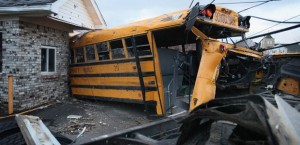Hoosier Schools Could Plan Better For Emergencies
Indiana could do more when it comes to emergency preparedness.

Scott Olson / Getty Images
A new national report places Indiana among the states considered the least prepared in the event of an emergency.
According to a report released Tuesday by international charity Save the Children, the Hoosier state is one of 15 states that lacks a number of elements the organization deems “standard” for addressing natural and manmade emergencies.
Save the Children’s annual National Report Card on Protecting Children in Disasters cites four minimum emergency preparedness standards states must meet: an evacuation/relocation plan, a plan for children with special needs, a family-child reunification plan, and a K-12 multiple disaster plan.
Indiana only meets the latter two criteria, putting it ahead of only 10 other states.
The Indiana Department of Education requires each of the state’s school corporations to develop a written emergency preparedness plan, in consultation with local public safety agencies. State Board of Education rules require that plan to include the following, at minimum:
- Appropriate warning systems
- Procedures for notifying other agencies and organizations
- Posting of evacuation routes
- Emergency preparedness instruction for staff and students
- Public information procedures
- Steps to be taken prior to a decision to evacuate buildings or dismiss classes
- Provisions to protect the safety and well being of staff, students and the public in case of fire, natural disaster, adverse weather conditions, nuclear contamination, exposure to chemicals, or manmade occurrences (i.e. student disturbances, weapons, or kidnapping incidents)
School districts recognize the need to be prepared, particularly in a decade plagued by a number of school tragedies. In an interview with StateImpact in May, Doug Hasler, Executive Director of Support Services for Elkhart Community Schools, said his district has worked to upgrade its own safety and security measures.
“The list of school tragedies around the country has become longer and longer, and each and every one of those incidents has unfortunately taught an additional lesson of how it is possible to make a school safer for the students and the staff and the building,” Hasler says.
Despite a widespread desire for increased safety, Hasler says the obstacle standing in the way of his district, as well as others, is funding. Elkhart was able to secure money this past May through referenda.
“[It’s] a new priority, wanting to bring our buildings up to the safety standards that exist today,” Hasler explains. “We’ve looked around at our buildings and we’ve made changes where we can, but a number of those changes are things that we have not been able to do because we really need a sizable amount of funding to accomplish some of those things, far beyond the means that our capital projects fund would have available to it.”
Of every $10 in federal emergency preparedness grants, less than one cent has gone toward activities targeting children’s safety, according to Save the Children calculations.
More than half of U.S. families have been affected by some type of disaster, be it natural such as a tornado or flood, or more localized such as a building fire or school shootings. And parents are anxious. More than two-thirds worry about the risks to their children from disaster or emergency. Three out of four don’t believe the government is prepared to protect kids.
The U.S. Department of Education, along with the federal Departments of Justice and Health and Human Services, will begin administering a number of new school safety programs beginning in October. The programs come as part of a plan President Barack Obama’s instituted after the massacre at Newtown, Connecticut’s Sandy Hook Elementary School in December 2012.
David Esquith, director of the USDOE’s Office of Safe and Healthy Students, says these efforts aim to keep schools and communities safe, something he hopes will not require such intense focus in the future.
“When manmade or natural disasters impact school districts, the Department of Education makes every effort to help the community restore the learning environment,” Esquith says. “That said, we look forward to the day when [projects are] no longer necessary to address manmade disasters, and our efforts to prevent senseless violence enable all students, family and staff to thrive in a safe school environment.”
These new programs include grants to state education agencies to help them improve school climate as well as provide technical assistance to school districts to improve their emergency operation plans.